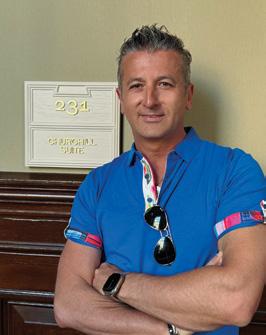
2 minute read
LONDON CALLING WITH PREMIUM TRAVEL EXPERIENCES
Amex Concierge services make enjoying one of the worldʼs greatest cities convenient, exclusive and accessible
WRITTEN BY RICK MULLER | JOURNEYED BY FERNANDO ZERILLO
London is one of the world’s most popular tourist destinations, attracting millions of visitors every year. As a result, gaining access to some of its most popular restaurants, bars, hotels and world-famous sites and events can sometimes be a challenge — and that’s why Amex’s Concierge services can be so valuable even to the most experienced travellers.
Designed to provide a seamless, elevated travel experience for Amex Premium cardholders, Amex concierge services make ground transport, premium hotel and restaurant reservations and tickets to exclusive events convenient, exclusive and accessible.
Dolce co-founder and Creative Director Fernando Zerillo had the pleasure of experiencing the full range of the Amex concierge services on a recent trip to the U.K., which began when he checked in at the Air Canada business class desk and a representative escorted him to the Air Canada lounge.
After enjoying the premium on-board service of Air Canada business class and arriving at Heathrow, Zerillo stopped first at the Fairmont Windsor Park Hotel in Windsor, a pleasant drive that took only 20 minutes from the airport, as opposed to the two hours it might take to transfer from city airport to country in any major North American city.
The Fairmont Windsor, a splendid hotel situated in a enchanted park-like forest of lush foliage and mature trees, is just steps away from Windsor Deer Park and its hundreds of deer, adjacent to Windsor Castle. Members of the Royal Family are known to occasionally be spotted enjoying the private tennis courts at Windsor Park.
Located on the edge of the historic Windsor Great Park, this luxury spa hotel is surrounded by 40 acres of open green space and beside a tranquil lake. Having an exquisite dinner on the patio overlooking the backdrop of the building’s majestic brickwork and the beautifully landscaped courtyard is the perfect way to drink in the English countryside. The spacious guest rooms are charming in every way, from their large circular windows overlooking the impressive, manicured grounds to the rooms’ wallpaper accents that bring the spirit of the foliage inside.
After two peaceful days of carriage rides and sightseeing some of Windsor’s historic sites, Zerillo’s next stop was the vibrant city of London, a place that can seem so familiar to the rest of the world because we see so much of it on television. Whether through royal weddings, state funerals or the recent coronation of King Charles, we know the places, monuments and buildings of the capital, including the Parliament Buildings, Buckingham Palace, Big Ben and Trafalgar Square, even if we’ve never set foot there. But that is the “grand” London, buildings and places designed and built to convey the power of the British Empire. The city itself, however, is a patchwork collection of small villages and neighbourhoods — some famous, such as Mayfair, Sloane Square, Knightsbridge and Notting Hill, and some not so famous, such as the adorable Frog Hollow, a small collection of streets and quaint shops near Kensington Gate.






And each of these neighbourhoods seems to have a grand hotel. Zerillo’s next stop upon his return to London was to stay at Raffles London, located in the heart of Whitehall at The Old War Office (OWO). Raffles London, like so many of London’s grandest hotels, features a grand central lobby. As is the tradition here, before Zerillo ascended the grand staircase he was careful to touch the lion’s head, which is said to bring good luck — and in London, you adhere to traditions!
This incredible marble masterpiece is one of the original Edwardian features of Raffles London at The OWO, originally designed by British architect William Young. Built in 1906, the building is one of the finest examples of the Edwardian Age and has a fascinating history. It contains many kilometres of storied corridors paced by Winston Churchill and his War Cabinet, which occupied a grand suite of offices in the building during the darkest days of the Second World War as they led the fight to save










